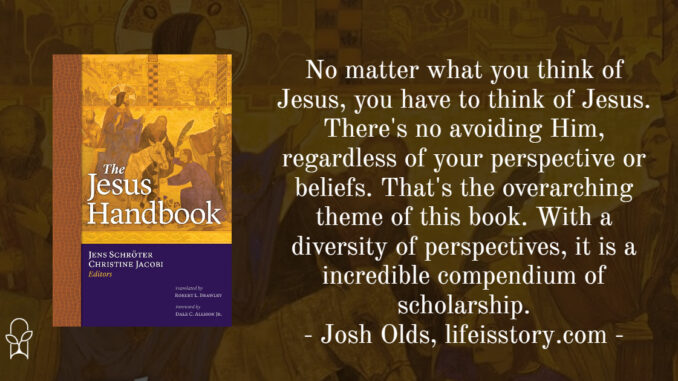
Published by Eerdmans on November 17, 2022
Genres: Academic
Buy on Amazon
Goodreads

An authoritative handbook on Jesus, his world, the outcomes of his life, and the quests to locate him in history.
The Jesus Handbook is an indispensable reference work featuring essays from an international team of renowned scholars on the significance and meaning of the life of Jesus of Nazareth. Rooted in historical-critical methodology, it emphasizes a diversity of perspectives and provides a spectrum of possible interpretations rather than a single unified portrait of Jesus. The Handbook’s dozens of authors—Jewish, Roman Catholic, and Protestant—all remain committed to the principle of interpreting the life of Jesus in context, while also giving due diligence to the implications of archaeological evidence and recent discourses in the hermeneutics of history.
After an introduction that lays out the considerations of the task at hand, the authors survey the history of Jesus research and take a close look at the historical material itself—textual and otherwise. From this foundation, the Handbook then details the life of Jesus before at last exploring the reception and effects of Jesus’s life after his death, especially in the first centuries CE. With this wealth of information available in a single volume, scholars and students of the New Testament and early Christianity—and anyone interested in the search for the historical Jesus—will find The Jesus Handbook to be a resource that they return to time and again for both its breadth and depth.
The Jesus Handbook is a historical-critical look at the historical Jesus, his world, and the impact of his life. Originally published in German in 2017, this comprehensive and wide-ranging exploration of the person of Jesus is a stalwart example of contemporary scholarship. It should be noted that this is not a “Christian” book. The contributors to this volume are Protestant, Catholic, and even Jewish. It utilizes historical-critical methodology and results in a range of perspectives. This is not a book about one Jesus. This is a book about how Jesus is viewed across a wide spectrum of beliefs and practices. Because, whoever else Jesus might be, He is a force to be reckoned with.
First, I must acknowledge the labor of Robert L. Brawley, who led the translation of this volume from German into English. It’s difficult enough to do casual translation work for a single author, let alone translate an academic anthology. Each of the forty-eight contributors to this anthology received a draft copy of the translation, then provided Brawley with emendations and corrections. Brawley notes that he also reached out to other scholars to discuss the best translation and that the process took nearly three years. Without this work, the English-speaking world would simply be missing out on this outstanding work of scholarship.
The Jesus Handbook is divided into five parts. The first part is an introduction that lays out the essential considerations and context for understanding Jesus. The second is a history of the historical-critical research on Jesus. The third part was the most interesting for me, as it dealt directly with the historical evidence for the person of Jesus. It’s a short part, but in a world that increasingly seems to believe there are no non-biased sources for Jesus’s existence, it is important to note that a critical academic work such as this finds plenty of such evidence. Part four discusses the life and work of Jesus—the political and religious context of his life and ministry, the biographical aspects of his life, and his public ministry. Again, I found this section interesting and engaging. The book this concludes with tracing the effect and reception of Jesus in the centuries following.
The book’s analysis is thorough and well-balanced, highlighting the strengths and weaknesses of various approaches to understanding Jesus. It benefits from a wide range of scholarly viewpoints, ensuring that readers are exposed to different interpretations and theories. The handbook’s inclusion of archaeological evidence and the latest scholarly discussions enhances its credibility and relevance. I didn’t agree with everything in The Jesus Handbook, but do so would be contradictory. The entire purpose of the book is to present the full corpus of academic thinking, meaning that contributors and perspectives often necessarily disagree. The editors make no attempt to reconcile these contradictions, leaving it to the reader to draw their own conclusions.
This is a unique work, outside of the realm of what I typically read. As a pastor and not an academic, I did find myself occasionally out of my depth in some areas. Nonetheless, the deep water is where you learn and The Jesus Handbook offered me a lot to think about that I had not thought about before. Its broad scope, combined with contributions from an impressive array of international scholars, makes it a standout work in the field of biblical studies. While the diversity of perspectives may be daunting for some, the book’s depth and breadth of scholarship ensure that it will be a valuable reference for years to come. My primary takeaway is that, no matter what you think of Jesus, you have to think of Jesus. There’s no avoiding or ignoring Him, no matter your theology or beliefs. His presence is simply too overwhelming…and maybe that in and of itself is something of importance.
